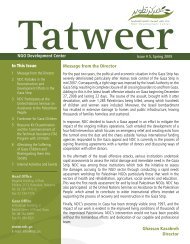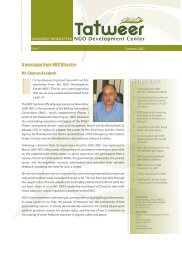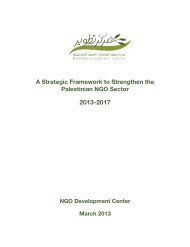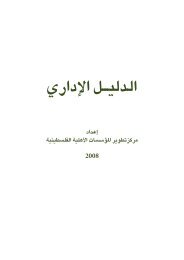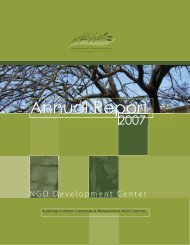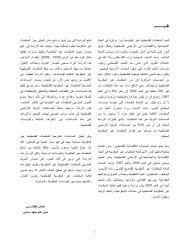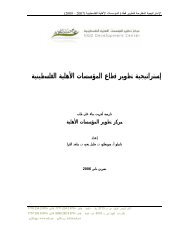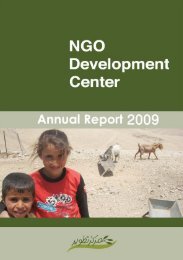Tracking External Donor Funding.pdf - NDC
Tracking External Donor Funding.pdf - NDC
Tracking External Donor Funding.pdf - NDC
Create successful ePaper yourself
Turn your PDF publications into a flip-book with our unique Google optimized e-Paper software.
2.3.4 The Question of Ownership in <strong>External</strong> Aid<br />
Having reviewed the structures of external aid<br />
coordination and the ways in which they have evolved<br />
over time to nurture Palestinian ownership, the<br />
following section reviews how Palestinians have taken<br />
advantage of the changing themes of development. The<br />
most pivotal points in this process were the<br />
announcement of the Paris Declaration on Aid<br />
Effectiveness and the 2007 launch of the PRDP.<br />
Though the debate over ownership had been going on in<br />
Palestine for some time, only in the past few years have<br />
local and international actors begun to turn the ideas of<br />
‘ownership’ into a more concrete structural reality 28 .<br />
‘In 2003, aid officials gathered in Rome for the<br />
High Level Forum on Harmonization, where donor<br />
countries agreed to better streamline and<br />
coordinate their aid efforts in the developing<br />
world. In the same year, the MoP drew up a Socio-<br />
Economic Stabilization Plan (SESP) in an attempt<br />
to steer donor assistance towards the deteriorating<br />
social and economic environment. Until 2000, most<br />
donor support was largely in the areas of<br />
institution-building and reconstruction. (…)As the<br />
Second Intifada extended into its third year, it<br />
became clear that funding priorities were no<br />
longer sustainable. The successive implementation<br />
from one year to another of emergency and relief<br />
plans, which are decoupled from development<br />
needs, leads t o dependency and donor fatigue.<br />
Through the SESP, the PA sought to regain the<br />
leadership of its development agenda and enhance<br />
the quality of its dialogue with the international<br />
donor community by providing a framework for<br />
foreign aid’ (MTDP, Forward).<br />
Work on the Medium Term Development Plan 2005 –<br />
2007 (MTDP) started in March 2004 and involved a core<br />
group of staff from the Ministry of Planning (MoP) and a<br />
wide range of counterparts from other line ministries of<br />
the Palestinian Authority (PA).<br />
Much like the SESP, the MTDP worked to transform the<br />
relationship between the PA and donor institutions.<br />
Despite the ongoing difficulties to development posed by<br />
the occupation, the PA recognized its responsibility to<br />
guide the development process 'within the limits of the<br />
occupation' (MTDP, 2005-2007, Forward). The MTDP<br />
attempts simultaneously to pursue relief efforts and<br />
address development issues in a way that sustainably<br />
addresses two of the WB&GS’s most prominent needs:<br />
the reduction of poverty and the building of institutions<br />
(ibid).<br />
In 2005, representatives of over 100 countries and dozens<br />
of international NGOs signed the Paris Declaration on<br />
Aid Effectiveness. Unlike the Rome Declaration on<br />
Harmonization, which focused on relations between<br />
donors, the Paris Declaration laid out a framework for<br />
relations between donors and recipients. The Declaration<br />
is focused on five mutually reinforcing principles.<br />
Paris Principles on Aid Effectiveness (2005)<br />
• Ownership: Developing countries must lead their own development policies and strategies, and manage their own<br />
development work on the ground. The target set in Paris was that 75% of developing countries would produce their own<br />
national development strategies by 2010.<br />
• Alignment: <strong>Donor</strong>s must line up their aid firmly behind the priorities outlined in developing countries’ national development<br />
strategies.<br />
• Harmonization: <strong>Donor</strong>s must coordinate their development work better amongst themselves to avoid duplication and high<br />
transaction costs for poor countries. They agreed on a target of providing two-thirds of all their aid via so-called “programbased<br />
approaches” by 2010.<br />
• Managing for results: All parties in the aid relationship must place more focus on the end result of aid and must develop<br />
better tools and systems to measure this impact.<br />
• Mutual accountability: <strong>Donor</strong>s and developing countries must account more transparently to each other for their use of aid<br />
funds, and to their citizens and parliaments for the impact of their aid.<br />
28<br />
For more information on early research in development initiatives, see: Abdelkarim 2005; Adullah 2005; and Al-Naqib 2003, 2004.<br />
22


